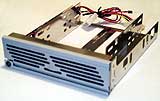
InClose BayCooler 2 hard drive cooler
Review date: 22 December 1999.Last modified 03-Dec-2011.
Hard disks run hot. There's air in there, and there's platters going round and round very quickly, and friction between the platters and the air makes heat. Drives can run surprisingly hot without having any problems, but the warmer the weather in your computer room and the faster your hard drive, the better an idea some sort of drive cooler becomes.
5400 revolution per minute (RPM) hard drives don't generally need any sort of special cooling. They may last a bit longer with some airflow over them, but it really makes little difference. The 7200RPM drives most people use at present run warmer, but again generally survive OK without special cooling. It depends; if you live somewhere hot, and especially if your case ventilation ain't that great (for more on that subject, see here), it can be a good idea to specially cool a 7200RPM drive. But don't go nuts.
10,000RPM drives, on the other hand, are not at all happy mounted somewhere where they don't get a nice cool breeze across 'em. Owners of these speed-demon storage devices really should cool them properly.
The simplest, and probably the best, way to cool 3.5 inch hard drives in a normal computer case is with a 5.25 inch bay cooler arrangement. The drive mounts on adaptor rails in the larger drive bay, a front panel with one, two or three little fans in it mounts where the faceplate of a 5.25 inch device like a CD-ROM drive would go, it all connects
InClose Design's BayCooler 2 is a classy implementation of this basic idea. Instead of the separate mounting rail and plastic faceplate design of most such coolers, it's all one piece, with the mounting chassis made of sturdy steel plate. This makes it easier to install and move - it's all of a piece with the drive, when assembled - and also may provide somewhat better cooling, thanks to the larger heat sink and contact area of the steel frame.
The BayCooler retails for a quite reasonable $US29. This is substantially more than you'll pay for a superficially similar separate-rails cooler, but it's still very cheap compared with the monster drives many users will be pointing it at. Some cheaper coolers don't come with a dust filter, either; filling your computer with air-gunk isn't actually as bad as you might think, and hard drives have their own filters that keep crud out very effectively, but a filter is still a nice thing to have.
Cheaper filters may also have very dodgy fans in them. They pretty much all use 40mm slimline fans, and so does the BayCooler 2, but at least it's got three nice sculpted-fin units, which should move a reasonable amount of air.
What you get
The BayCooler package doesn't have any surprises in it. One drive cooler, with power lead featuring pass-through Molex power lead (so you can plug it into the back of the drive and not use another power supply connector).
Three fans. Dust filter. Double-header drive activity LED connector, which you can plug into the back of the drive if you want the orange LED on the front of the BayCooler to indicate drive activity. Little bag of screws.
You don't get a manual with the BayCooler 2, but you don't really need one; there are installation instructions on the BayCooler site, in case you get confused. But it's pretty difficult to do so.
Using it
There's not much to say about using a hard disk cooler, of course; it sits there, hums gently, and keeps your drive cool. The BayCooler 2 does, however, make it simple to clean the dust filter - which is something you should do regularly. The front panel unclips easily so you can remove the filter. There's no need to unscrew anything, or turn off the PC.
Overall
If you've just dropped hundreds and hundreds of dollars on a bleeding edge drive, for Pete's sake get a cooler for it. The BayCooler 2 looks like an excellent choice; not very expensive, solidly made, easy to install, and with a sensible filter design. Recommended.




